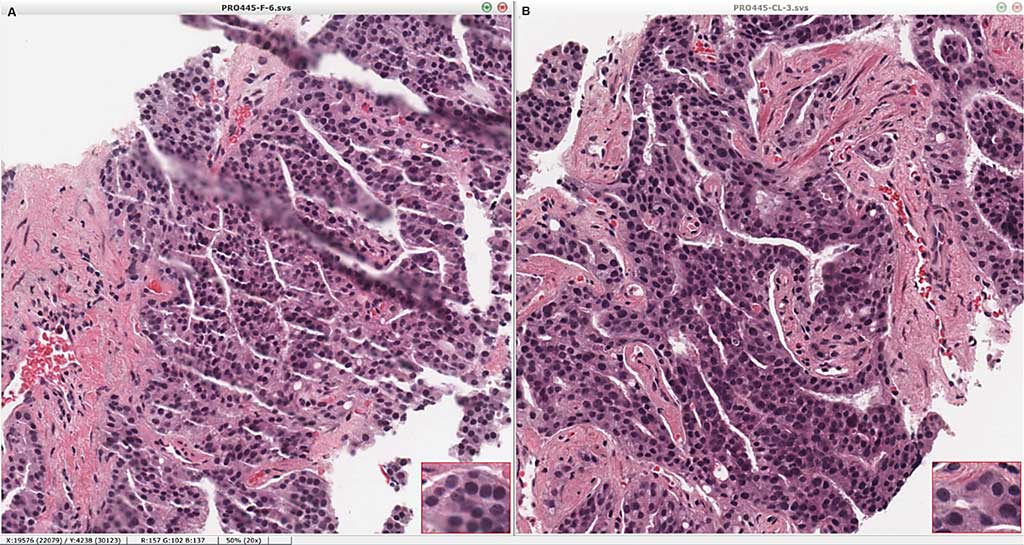Rapid, Direct-to-Digital Prostate Biopsy Pathology Evaluated
By LabMedica International staff writers
Posted on 13 May 2021
Increasing adoption of digital pathology promises marked improvements in reproducibility, efficiency, and accuracy of tissue-based diagnostics by facilitating routine remote expert consultation and enabling computerized image analysis for clinical use.Posted on 13 May 2021
Clearing histology with multiphoton microscopy (CHiMP) is a new technique for tissue processing and image acquisition that eliminates conventional paraffin embedding by incorporating fluorescent staining during preparation steps and then uses a fast, high-resolution laser-scanning multiphoton microscope to acquire images on intact tissue.

Image: Standard hematoxylin-eosin sections are unaffected by processing and imaging by clearing histology with multiphoton microscopy (CHiMP). Portions of the same core biopsy were submitted directly to standard processing (A) or processed by CHiMP and subsequently embedded in paraffin, sectioned, and stained (B), showing equivalent coloration and morphology (Photo courtesy of Yale School of Medicine)
Medical Laboratory Scientists at Yale School of Medicine (New Haven, CT, USA) analyzed samples from 40 patients with a high likelihood of prostate cancer based on magnetic resonance imaging consented to investigational core biopsy. A subset of samples was used for direct comparison of physical slide preparation effects and time-tracking determination with multiphoton microscopy. Twenty samples were processed for diagnostic comparison between multilevel digital slides and subsequently produced physical slides. A reference diagnosis based on all data was established using grade groups. Level of diagnostic match and requests for immunohistochemistry were compared between physical and digital diagnoses. Immunohistochemical staining and length measurements were secondary outcomes.
Imaging of pathologist study specimens was performed in a prototype specialized ultrafast multiphoton microscope supplied by the startup company Applikate Technologies (Weston, CT, USA) that incorporates a femtosecond pulsed laser and a 0.95 numerical aperture benzyl alcohol/benzyl benzoate immersion objective. All physical tissue slides were imaged using an Aperio ScanScope (Leica Biosystems, Wetzlar, Germany) at ×40 equivalent resolution for digital storage and preparation of figures.
The scientists reported that interpretations based on direct multiphoton imaging yielded diagnoses that were at least as accurate as standard histology; cancer diagnosis correlation was 89% (51 of 57) by physical slides and 95% (53 of 56) by multiphoton microscopy. Grade-level concordance was 73% (44 of 60) by either method. Immunohistochemistry for routine prostate cancer–associated markers on these alternatively processed tissues was unaffected. Alternatively processed tissues resulted in longer measured core and cancer lengths, suggestive of improved orientation and visualization.
The authors concluded that their study demonstrates the viability of using direct digital imaging for definitive microscopic evaluation of tissue without requiring physical slide preparation for gold standard–level diagnosis. Overall, results support practical relevance of the CHiMP technique for prostate biopsy evaluation, with the potential to significantly advance prostate cancer diagnostics, and meriting continuing detailed validation as a process incorporated into clinical diagnostic practice. The study was published in the May, 2021 issue of the journal Archives of Pathology and Laboratory Medicine.
Related Links:
Yale School of Medicine
Leica Biosystems













